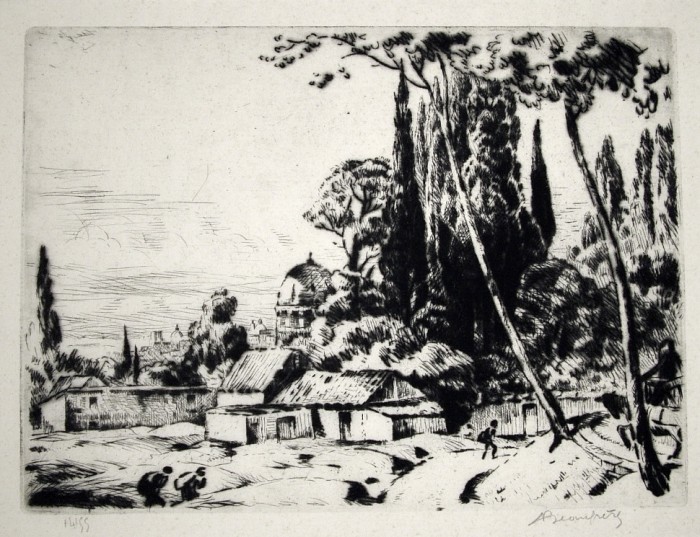Aux Approches de Madrid (also Aux Abords de la Ville)

Adolphe-Marie Beaufrere (1876-1960), Aux Approches de Madrid (also Aux Abords de la Ville), drypoint, 1927, signed and numbered (14/55), from the edition of 55, with the blindstamp of Sagot, publisher (Lugt 2254). Reference: Morane 27-19. In good condition, on very thin cream Japan paper, 6 1/2 x 9, the sheet 8 3/8 x 11 1/4 inches, archival matting.
A fine impression, with the drypoint burr extremely rich and effective (due in part to the use of a Japan paper, which tends to diffuse the ink surrounding the drypoint lines).
Beaufrere was born at Quimperle, in Brittany, and though he traveled widely he re-connected with this area throughout his life. As a teenager he decided that he wanted to become an artist and he traveled to Paris where, shortly after his arrival, he encountered the eminent Gustave Moreau, who took him on as a student. Moreau encouraged him to study old master prints, especially the prints of Rembrandt and Durer, which were available in the Cabinet des Estampes in Paris – this was to be critical in his development.
Beaufrere began printmaking in about 1904, with some woodcuts, but soon got into etching and engraving. Curiously, one of his colleague/teachers at the time was the Canadian etcher Donald Shaw MacLaughlan. He began showing his prints, with some success, but after his marriage in 1905, and with the urging of his new wife, moved out of Paris and back to Brittany. This move had a mixed effect on his career – contacts with other artists became fewer, but he did maintain gallery relationships, and the French countryside and it’s inhabitants would provide a continuing source of inspiration.
During the Great War Beaufrere served in the infantry, and had few opportunities to make art. But he did study a volume of Rembrandt’s prints, and wrote later that Rembrandt was his master, that there could be no better teacher of etching. Rembrandt’s continuing influence is evident in works such as Aux Approches de Madrid, particularly the use of drypoint against Japan paper, and the composition is remindful of a number of Rembrandt works such as Three Gabled Cottages (Bartsch 217).
After the War Beaufrere experienced great success, both in France and the US. He traveled a bit, in France (and here, in Spain), and received many awards (including Chevalier of the Legion of Honor in 1939, nominated by his friend Jean-Emile Laboureur). And throughout his life, despite various maladies including eye problems in the ’40’s and later, he continued to make prints as well as paintings and watercolors.